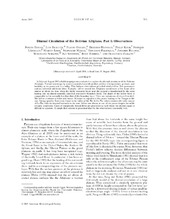Diurnal Circulation of the Bolivan Altiplano. Part I: Observations
Egger, Joseph; Blacutt, Luis; Ghezzi, Flavio; Heinrich, Richard; Kolb, Philip; Lämmlein, Stephan; Leeb, Martin; Mayer, Stephanie; Palenque, Eduardo; Reuder, Joachim; Schäper, Wolfgang; Schween, Jan; Torrez, Rene; Zaratti, Francesco
Journal article

Åpne
Permanent lenke
https://hdl.handle.net/1956/714Utgivelsesdato
2005-04Metadata
Vis full innførselSamlinger
- Geophysical Institute [1198]
Originalversjon
https://doi.org/10.1175/mwr2894.1Sammendrag
In July and August 2003 a field campaign was conducted to explore the diurnal circulation of the Bolivian Altiplano. Vertical soundings by remote-controlled aircraft yielded profiles of temperature, pressure, and humidity at six passes and in a valley. Pilot balloon observations provided wind profiles. Two permanent stations collected additional data. Typically, inflow toward the Altiplano commences a few hours after sunrise at about the time when the stable nocturnal layer near the ground is transformed by the solar heating into an almost neutrally stratified convective boundary layer. The depth of the inflow layer is comparable to but normally less than that of this boundary layer. There are indications of return flow aloft. The inflow continues at least until sunset. Moisture is imported at the passes leading to the Yungas in the east. Strong upvalley flows were found in the valley of the Rio de La Paz, which connects the wide canyon of La Paz with the tropical lowlands to the east. Inflow was absent at one of the passes despite favorable synoptic conditions. Cases of synoptically forced flows are presented as well where the diurnal signal is difficult to separate. A simple flow scheme is presented that fits the observations reasonably well.